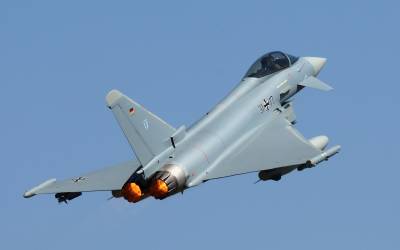Italian Eurofighters (click to view full) The multi-national Eurofighter Typhoon has been described as the aerodynamic apotheosis of lessons learned from the twin engine "teen series" fighters that began with the F-14 and F-15, continued with the emergence of the...
Industry & Trends Articles
Elbit Unveiled Air Keeper | Nigerian Army to Power Vehicles With Natural Gas | Taiwan Frontline Island On Alert
Americas Elbit Systems has unveiled the Air Keeper, a revolutionary airborne system designed to integrate Intelligence, Surveillance, Target Acquisition, and Reconnaissance (ISTAR) capabilities with Electronic Warfare (EW) functionalities on a single platform. The Air...
USN To Test Onboard Microwave Weapon in 2026 | SANDF Seeks To Modernize Samil Trucks | Indonesia Ordered 2 Scorpene Class Subs
Americas The US Navy plans to mount a high-powered microwave-based counter-air defense system prototype on one of its vessels in 2026. The Meteor will be the navy’s first high-powered microwave (HPM) project to counter targets such as drones and anti-ship missiles,...
US Hellfire Missile Orders, FY 2011-2024
USN MH-60S test (click to view full) Hellfire I/II missiles are the USA's preferred aerial anti-armor missile, and are widely deployed with America's allies. They equip America's helicopter fleets (AH-64, AH-1, OH-58D, MH-60S/R), AH-64 and S-70 helicopters flown by...
Boeing Tapped For Apache Support | Hensoldt Nearing Bushbaby Completion | US Deployed B-1Bs To Spain
Americas Boeing won a $116 million hybrid deal for Apache logistics support. Bids were solicited via the internet with one received. Work will be performed in Mesa, Arizona, with an estimated completion date of April 30, 2025. Fiscal 2024 Army working capital funds in...
AH-64E Apache Block III: Evolving Battlefield Roles
AH-64 in Afghanistan (click to view full) The AH-64 Apache will remain the US Army's primary armed helicopter for several more decades, thanks to the collapse of the RAH-66 Comanche program, and the retirement sans replacement of the US Army's Armed Reconnaissance...
GA Tested SDS Using SeaGuardian | France Delivers Carriers And Missiles To Ukraine | New Aussie Boeing Facility For Ghost Bat
Americas General Atomics Aeronautical Systems won a $561 million cost-plus-fixed-fee contract for Gray Eagle technical services. Bids were solicited via the internet with one received. Work locations and funding will be determined with each order, with an estimated...
ER/MP Gray Eagle: Enhanced MQ-1C Predators for the Army
ER/MP, armed (click to view full) Its initial battles were fought within the Pentagon, but the US Army's high-end UAV has made its transition to the battlefield. The ER/MP program was part of the US Army's reinvestment of dollars from the canceled RAH-66 Comanche...
MQ-9 Reaper: Unfettered for Export
0 Reaper, ready... (click to view full) The MQ-9 Reaper UAV, once called "Predator B," is somewhat similar to the famous Predator. Until you look at the tail. Or its size. Or its weapons. It's called "Reaper" for a reason: while it packs the same surveillance gear,...





